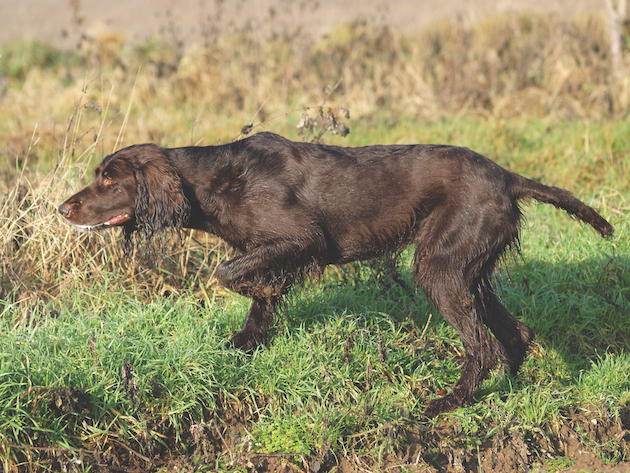So why do gundogs have floppy ears?
All gundog breeds may have floppy ears but they are equipped with hearing many times more sensitive than ours, says David Tomlinson

German longhaired pointer
See a dog with floppy ears and it’s going to be a gundog.
One feature common to every breed of gundog is floppy ears. Spaniel ears flop considerably more than those of, say, Labradors or German shorthaired pointers, but all the gundogs have ears that flap downwards, unlike such breeds as German shepherds, greyhounds and Pomeranians.
Preference for dog with floppy ears
It’s a physical feature that we take for granted, but it’s the result of selective breeding that took place centuries ago. We humans like a dog with floppy ears, as it gives them a friendlier, less intimidating look.

All wild canids have pointed ears: this is a black-backed jackal in Namibia
However, it’s notable that all wild canids, without exception, have pointed ears. Ears that prick rather than flop are more efficient, which is why wolves and jackals have evolved with them.
If you watch a wolf (do so on YouTube), you will note that the animal is continually turning its ears in different directions to pick up sounds from every source, something a gundog cannot do. However, gundogs do prick their ears when they hear a noise. If they think it deserves investigation, they will usually turn their head towards it to hear it better.
We humans have a very limited ability to move our ears and most of us can barely twitch them. There are a mere six muscles controlling our ears, none of which is particularly effective. In contrast, a dog has 18 ear muscles, allowing it to tilt, rotate and funnel the sound into the inner ear more effectively. In addition, the canine ear canal is longer than ours. Muscles allow it to finely tune the position of this ear canal so that it can localise a sound, hear it more accurately and from farther away.
Not only do dogs have much more sensitive hearing than us, they also have the ability to pick up a sound four times further away than we can. In addition, they can hear much higher frequencies, which explains why the silent dog whistle can be so effective.
It’s worth remembering how sensitive your dog’s ears are when you are training. There’s no need to blow a whistle loudly as the dog will pick up even the softest of whistles at remarkably long ranges. However, we all have a natural inclination to blow a whistle louder and louder the further away a dog is, assuming from its lack of reaction that it hasn’t heard us. It has, of course, but it’s simply choosing to ignore it.
I was reminded recently of how far-carrying a dog whistle is. I was out walking with my sprocker, Emma, in a local wood. My wife, Jan, having met a friend, was walking our other spaniel, Rowan, on a different route.
At one stage, our paths came within about 300 yards of each other. I saw Emma stop and listen, then I heard, very faintly, Jan blowing her whistle. The fact that I could hear the whistle at such range was interesting, but it was a very still day. It was obvious that Emma heard it loud and clear, but she turned to me as if to check that I wasn’t the one blowing it.
I’m lucky to still have good hearing as I shot for most of my life without wearing hearing protection. Forty or 50 years ago, hardly anyone wore earplugs or ear defenders, which explains why there are so many elderly shooting men who are profoundly deaf, usually in their left ear — or, if they are left-handed, in their right ear. Though I spent a lot of time out with a gun, I didn’t fire it very often, probably only using around 150 cartridges a season.
Deafness
I’ve often wondered how a dog’s hearing is affected by shooting, particularly peg dogs or those that have shared a pigeon hide. I haven’t managed to find any research, but my guess is that a dog that is heavily shot over is bound to lose some of the sharpness of its hearing, perhaps leading eventually to deafness. If readers have any thoughts, I would be delighted to hear from them.
Dogs can hear sounds of up to 50,000 vibrations per second (50,000Hz), while for humans the upper limit is around 20,000Hz and the frequency lowers as we get older. So-called silent dog whistles emit a sound higher than 20,000Hz, which is why we don’t register them.
Silent whistles have never caught on with gundog handlers, though I’m sure that with the right handler they could be as effective as the sort of whistles most of us use. My guess is that this is because we like to hear the sound of our own whistle — we know that if we can hear it, the dog certainly can.
Historically, gundogs have never suffered the indignity of ear cropping, a nasty disfigurement inflicted on many breeds. The practice was banned in the UK many years ago, but it remains legal to import a dog with cropped ears from the Continent, as long as the cropping was performed by a veterinary surgeon.
Ears are usually cropped to make dogs such as Dobermanns and pit bull terriers appear more intimidating, while there is apparently a growing demand for cropped dogs prompted by certain so-called celebrities with such animals. I’m pleased to note that the Government is currently considering banning the import of these mutilated animals.








